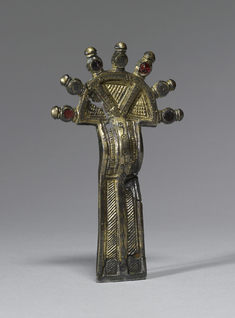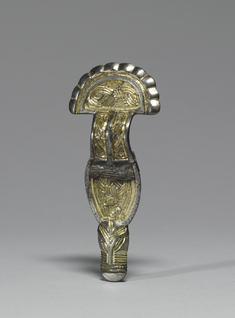Bow Fibula
Also called “digitated” fibulae due to the radiating knobs that resemble fingers or digits, these three pins show how a style changed over time. While the knobs of early (4th-century) fibulae were functional (holding the springs of the pin), they later became purely decorative. The five-knobbed fibula [54.2444] dates to the first half of the 6th century and was common in northern France and the Rhineland. Much less common, the seven-knobbed fibula [54.2443] is later in date. On the third fibula [54.2445], the knobs have degenerated into an undulating border, and the foot ends in a stylized animal head; this type of fibula has been found in graves dated to the later 6th or early 7th century, predominantly near the Rhine. They were worn in pairs at the shoulder by women with noble status in Frankish society.
Provenance
Provenance (from the French provenir, 'to come from/forth') is the chronology of the ownership, custody, or location of a historical object. Learn more about provenance at the Walters.
Carlebach Gallery, New York [date and mode of acquisition unknown]; Walters Art Museum, 1959, by purchase.
Exhibitions
| 1996 | Smith College Museum of Art Early Medieval Research. Smith College Museum of Art, Northampton. |
| 1984-1987 | Objects of Adornment: Five Thousand Years of Jewelry from the Walters Art Gallery, Baltimore. Cooper-Hewitt National Design Museum, New York; Chrysler Museum of Art, Norfolk; Carnegie Museum of Art, Pittsburgh; San Antonio Museum of Art, San Antonio; Philbrook Museum of Art, Tulsa; Honolulu Academy of Arts, Honolulu; New Orleans Museum of Art, New Orleans; Milwaukee Art Museum, Milwaukee; Minneapolis Institute of Art, Minneapolis; Toledo Museum of Art, Toledo; The John and Mable Ringling Museum of Art, Sarasota. |
| 1987 | eyJewelry from the Walters Art Gallery and the Zucker Family Collection. The Walters Art Gallery, Baltimore. |
| 1979-1980 | Jewelry - Ancient to Modern. The Walters Art Gallery, Baltimore. |
Conservation
| Date | Description | Narrative |
|---|---|---|
| 10/24/1960 | Treatment | cleaned; coated |
| 6/8/1983 | Loan Consideration | examined for loan |
| 4/19/1984 | Treatment | cleaned; coated |
| 4/19/1984 | Treatment | cleaned |
| 5/3/1996 | Loan Consideration | examined for loan |
Geographies
Germany, Rhineland
(Place of Origin)
France (Place of Origin)
Measurements
H: 3 9/16 x W: 2 x D: 5/16 in. (9.1 x 5.2 x 0.9 cm)
Credit Line
Museum purchase with funds provided by the S. & A.P. Fund, 1959
Location in Museum
Centre Street: Third Floor: Migration and Early Medieval Art
Accession Number
In libraries, galleries, museums, and archives, an accession number is a unique identifier assigned to each object in the collection.
In libraries, galleries, museums, and archives, an accession number is a unique identifier assigned to each object in the collection.
54.2444






